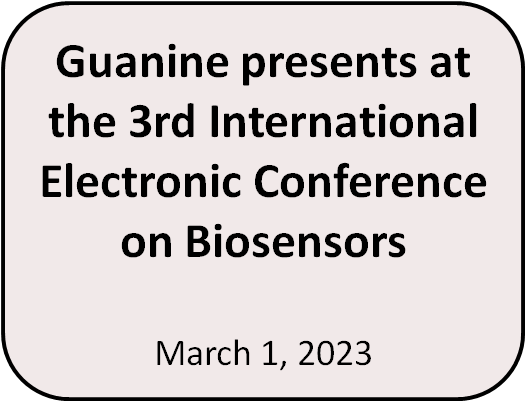What is syndromic testing?
Syndromic testing uses a multiplex test to detect the presence of a large number of potential pathogenic sources rather than a single pathogen for infections that have common symptoms.
Why is syndromic testing important?
Syndromic testing reduces the time for finding the appropriate treatment. This is critical for illnesses that need to be treated rapidly such as virulent infections that are drug resistant. Syndromic testing can also be used along with other techniques for rapidly assessing a wide range of biomarkers for the early detection of cancer, neurologic diseases, chronic illnesses and many other difficult to diagnose groups of illnesses that have common symptoms.
What is preventing the widespread use of syndromic testing?
Syndromic testing platforms employs multiplex PCR using high cost instruments, expensive reagents, highly skilled technicians and various lab resources which limit widespread use.
How is Guanine different than other syndromic testing platforms?
Guanine’s platform measures the detection signal from electrical current rather than distinguishing a low intensity difference in light caused by detection. Tests that generate electrons and measure electrical current are rapid, simple, inexpensive, and quantitative such as a glucose meter. As with Guanine’s test is provides concentrations instead of just present or absent. Guanine provides these benefits by binding targets with millions of guanine molecules delivered as electrochemically detectable oligonucleotide tags (EC-DOTs) on magnetic microparticles.
What other companies use electrical signals for detection?
A syndromic test from Roche’s GenMark ePlex uses electrochemical tags made of ferrocene. Each nucleic acid target is bound with a single iron (ferro) molecule which necessitates multiplex PCR to amplify the number of targets available for detection. In contrast Guanine avoids multiplex PCR by binding nucleic acid targets with millions of EC-DOTs rich in guanine molecules instead of replicating millions of copies. EC-DOTs is patented by Guanine and no other company uses them. A group of products directly measure electroactive materials in the blood such as glucose, blood gases and electrolytes without tags. These include Abbott’s i-STAT and Siemens Healthineers’ epoc Blood Analysis System. Because these materials are present in relatively high concentrations, they do not require signal amplification.
Why is concentration important for diagnosis?
Concentrations give additional information for treatment. For example blood sugar (glucose) concentration that are too high (hyperglycemia) or too low (hypoglycemia), can be dangerous for people with diabetes and can lead to complications. Other factors can predict the type of complications such as the duration of time that the glucose level is concentration is outside of the normal range, as well as the patient’s type of diabetes, symptoms, age and medications.
The COVID pandemic used qualitative present/absence testing that did not indicate concentrations. An infected patient with 50,000 COVID particles/mL would be positive with a PCR test but negative with an antigen test. The same patient with residual COVID nucleic acids after a month would not be infective but would potentially test positive with a PCR test even though the concentration could have dropped by 95%. Quantitative information is used in viral loads for HIV can indicate disease severity as well as the treatment effectiveness to allow better and more timely decisions to be made. Guanine provides concentrations for every test which can in time can allow healthcare professional to make better and more timely decisions. A follow-up Guanine test can tell if the infection is getting better or worse. This can help with treatment decisions and other important decisions.
Syndromic testing uses a multiplex test to detect the presence of a large number of potential pathogenic sources rather than a single pathogen for infections that have common symptoms.
Why is syndromic testing important?
Syndromic testing reduces the time for finding the appropriate treatment. This is critical for illnesses that need to be treated rapidly such as virulent infections that are drug resistant. Syndromic testing can also be used along with other techniques for rapidly assessing a wide range of biomarkers for the early detection of cancer, neurologic diseases, chronic illnesses and many other difficult to diagnose groups of illnesses that have common symptoms.
What is preventing the widespread use of syndromic testing?
Syndromic testing platforms employs multiplex PCR using high cost instruments, expensive reagents, highly skilled technicians and various lab resources which limit widespread use.
How is Guanine different than other syndromic testing platforms?
Guanine’s platform measures the detection signal from electrical current rather than distinguishing a low intensity difference in light caused by detection. Tests that generate electrons and measure electrical current are rapid, simple, inexpensive, and quantitative such as a glucose meter. As with Guanine’s test is provides concentrations instead of just present or absent. Guanine provides these benefits by binding targets with millions of guanine molecules delivered as electrochemically detectable oligonucleotide tags (EC-DOTs) on magnetic microparticles.
What other companies use electrical signals for detection?
A syndromic test from Roche’s GenMark ePlex uses electrochemical tags made of ferrocene. Each nucleic acid target is bound with a single iron (ferro) molecule which necessitates multiplex PCR to amplify the number of targets available for detection. In contrast Guanine avoids multiplex PCR by binding nucleic acid targets with millions of EC-DOTs rich in guanine molecules instead of replicating millions of copies. EC-DOTs is patented by Guanine and no other company uses them. A group of products directly measure electroactive materials in the blood such as glucose, blood gases and electrolytes without tags. These include Abbott’s i-STAT and Siemens Healthineers’ epoc Blood Analysis System. Because these materials are present in relatively high concentrations, they do not require signal amplification.
Why is concentration important for diagnosis?
Concentrations give additional information for treatment. For example blood sugar (glucose) concentration that are too high (hyperglycemia) or too low (hypoglycemia), can be dangerous for people with diabetes and can lead to complications. Other factors can predict the type of complications such as the duration of time that the glucose level is concentration is outside of the normal range, as well as the patient’s type of diabetes, symptoms, age and medications.
The COVID pandemic used qualitative present/absence testing that did not indicate concentrations. An infected patient with 50,000 COVID particles/mL would be positive with a PCR test but negative with an antigen test. The same patient with residual COVID nucleic acids after a month would not be infective but would potentially test positive with a PCR test even though the concentration could have dropped by 95%. Quantitative information is used in viral loads for HIV can indicate disease severity as well as the treatment effectiveness to allow better and more timely decisions to be made. Guanine provides concentrations for every test which can in time can allow healthcare professional to make better and more timely decisions. A follow-up Guanine test can tell if the infection is getting better or worse. This can help with treatment decisions and other important decisions.
- Detection of Pathogens and Antimicrobial Resistance Genes at Low Concentration via Electrochemical Oligonucleotide Tags Gordon, N., Bawa, R., Palmateer, G. Eng. Proc. (2023), 35, 28. https://doi.org/10.3390/IECB2023-14584
- Carbapenem-Resistant Enterobacteriaceae Testing in 45 Minutes using Oligonucleotide Detection Tags
Gordon, N., Bawa, R., Palmateer, G., Rajabi, M., Gordon J.B., Kotb, N.M., Balasubramaniyam, R, Gordon, B.R. Advances in Medical Imaging, Detection, and Diagnosis. Volume 4, Chapter 26, Jenny Stanford Publishing (2023) - Advancements in medical AI and precision medicine are constrained by antiquated IVD technologies Guanine Technology Series - Issue 1, August 2023
- Universal Bioanalyte Signal Amplification for Electrochemical Biosensor Gordon, N. Biosensors J 5: 135 (2016)
- Highly Sensitive Bacteria Quantification Using Immunomagnetic Separation and Electrochemical Detection of Guanine-Labeled Secondary Beads Jayamohan, H. Gale, B.K,. Minson, B.J., Lambert, C.J., Gordon, N., Sant, H.J. Sensors, 15, 12034–12052 (2015).
Sepsis Mortality
Sepsis Cost Per Patient
Sepsis Healthcare Costs
Sepsis Drug Resistance Percentage
Post Sepsis Syndrome (PSS)
- There are 1,700,000 US sepsis cases/yr (30-50 million global), and 350,000 US sepsis deaths/yr (11 million global).
- Sepsis accounts for more than 50% of hospital deaths
- Sepsis mortality increases dramatically with greater disease severity: 10–20% for sepsis, 20–40% for severe sepsis, and 40–80% for septic shock
- Each elapsed hour between ED registration and antibiotic administration was associated with a 9% increase in the odds of mortality.
Sepsis Cost Per Patient
- Sepsis cost per patient varied widely by sepsis present at admission ($18,023) and not present at admission ($51,022)
- The mean length of stay dramatically increases with sepsis severity: 4.5 days for sepsis, and 16.5 days for septic shock
Sepsis Healthcare Costs
- Large US hospitals (500 or more beds) lose $34 million/year from non-reimbursed sepsis expenses. Small hospitals lose $10 million/year.
- Septicemia, the most common principal diagnosis among nonmaternal, nonneonatal stays in 2018, accounted for $41.5 billion in aggregate costs.
Sepsis Drug Resistance Percentage
- 50% of sepsis cases are due to resistant bacteria
- 61.35% of the antibiotics used showed resistance rates of more than 50%
- The study’s net prevalence for at least 1 resistant gram-positive organism (ie, MRSA or VRE) was 13.6% (2376 patients), and for at least 1 resistant gram-negative organism (ie, CTX-RO, ESBL, or CRE), it was 13.2% (2297 patients).
Post Sepsis Syndrome (PSS)
- 60% of sepsis patients are re-hospitalization with post sepsis syndrome (PSS) within 12 months and result in a high incidence of permanent organ damage, cognitive impairment, and physical disability
- Approximately 1 in 3 PSS survivors die in the year following sepsis, 1 in 5 have a potentially preventable rehospitalization, and 1 in 6 experience severe persistent physical or cognitive impairments.
- The mortality rate within one year after hospital discharge ranges between 7% and 43% and five-year mortality rates after sepsis are between 44% and 82%.
Guanine oxidation
Precision Medicine AI
Precision Medicine AI









